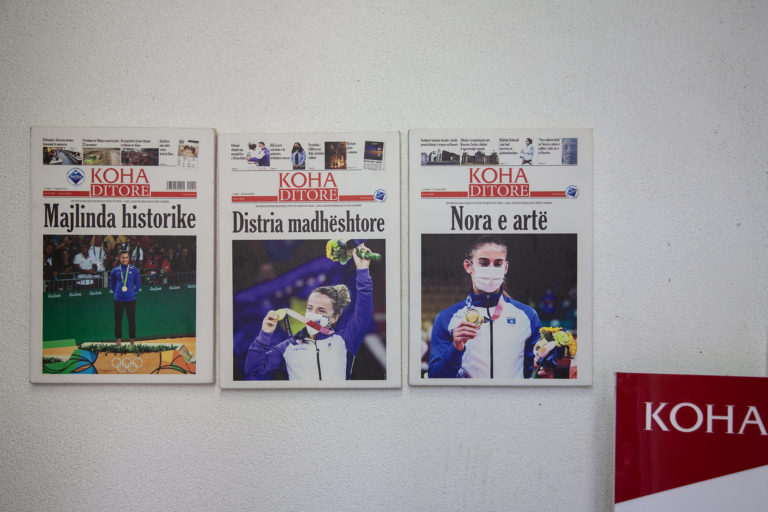Article 1 of the series: Surviving Kosovo’s Crowded Media Landscape
Author: Gentiana Paçarizi
Punctuated by its recent history of war and independence, and also the worldwide context post Covid-19, Kosovo’s ‘young’ media landscape is characterised by significant rivalry and limited funding opportunities. Within the global need for media renewal and a constrained Kosovo’s advertising market, the challenge of independence is a tough business, but highlights the resilience of its media outlets.

KTV offices – © Majlinda Hoxha / K2.0
The advent of the digital age is a ‘change or die’ scenario for Kosovo’s traditional media
At the entrance to the Prishtina offices of the media house KOHA Group, three covers of the Koha Ditore newspaper are displayed in a row on the wall. The issues, from August 2016 and July 2021, feature Majlinda Kelmendi, Distria Krasniqi, and Nora Kelmendi. "The Historical Majlinda," "The Magnificent Distria," "The Golden Nora" read the titles. All three are judo champions from Kosovo who have won medals in international competitions.
The front pages of the newspapers, featuring "Koha Ditore" in prominent red letters, were a familiar sight in newspaper kiosks throughout Kosovo from 1997 until the pandemic.
For a long time, Koha Ditore was one of the most popular print newspapers and had the longest track record in the media landscape. It is part of the media house KOHA, which also includes the television channel Kohavision, the online news portal Koha.net, the 24-hour news channel Arta, and a publishing house.
But due to rapid developments in the media market, including technological and digital shifts and the rise of online media, the print newspapers had difficulty finding a sustainable financial model in a country with a limited and competitive advertising market.
Covid 19's impact
The first year of the Covid-19 pandemic only made things worse. Three days after the first case of Covid was announced in Kosovo, the then government took a series of measures to prevent the spread of the virus. The measures, in addition to closing many businesses, also posed challenges for newspaper printing and distribution. The printing of the four daily newspapers, including Koha Ditore, became difficult to sustain.
In 2020, Kosovo became the only country in Europe without any print newspapers.
For Koha Ditore, stopping their print journalism in 2020 was initially a temporary decision. But things changed when inflation and rising costs struck the global economy. This affected the price of paper, ink, and other necessary material. As a result, KOHA decided to continue publishing the newspaper online in PDF form.
Brikenda Rexhepi, editor-in-chief at KOHA, said that bringing back the print newspaper was impossible due to the significant increase in printing costs. According to her, attracting businesses to advertise in the newspaper again was a further challenge, due to the fact that businesses had started to focus their advertising on online media.
"We are still doing the same work and will continue to. We publish the content of the newspaper as well as the technical editing, as we call the layout—but it just is not printed," said Rexhepi. "We do this to keep a sense of continuity and to serve as an archive of events, but also as a record of the newspaper’s existence."

Koha Ditore print – © Majlinda Hoxha / K2.0
Raising and lowering paywall
Although the pandemic played a significant role in ending print journalism in Kosovo, its decline started well before. Print newspapers' struggle for survival reflects the trajectory of Kosovo’s post-war media landscape.
After the end of the war in Kosovo, Kosovars could buy many different newspapers in kiosks and small shops. They were the second source of information after television and they also dominated the advertising market. In 2000, there were already 93 radio stations, 24 television stations (three national and 21 local) and 17 newspapers (six daily and 11 periodicals) in Kosovo. In addition, the public broadcaster had a television channel and two radio stations.
According to Rexhepi, during this time, even though the newspaper did not generate substantial profits, the revenue from sales and advertisements covered printing costs. As the number of national and cable television channels increased and online media platforms emerged, businesses and the government started to redirect their advertising money and audiences started going elsewhere.
This led to a decrease in newspaper sales. As of 2015, 20,000 to 25,000 issues were sold per day, one for every 200 residents. After transitioning from the printed newspaper to the online version, Koha Ditore lost 70% of its advertising revenue and did not make any profits as the online newspaper was offered for free for several months.
The decrease in income over the years has also affected the number of staff that KOHA can hire to meet editorial needs.
"The financial cuts have affected us, for example, if before in a particular field of media we had two journalists, now we can only have one journalist," said Rexhepi.
In addition to the difficulty in keeping staffing levels high enough, Rexhepi said that they are constantly faced with the difficulty of maintaining professional capacities due to the competition from the new media outlets, which offer better financial prospects and have recruited staff from their newsroom.
Today, KOHA has 200 employees, 80 of whom work in the newsroom.
In an effort to address their fragile financial situation, in 2021 KOHA became the first media outlet in Kosovo to introduce a subscription model and paywall for their online newspaper and news portal. Though they've gotten subscribers, Rexhepi said that they are planning to discontinue this funding model, which has not been a success.
"One of the reasons was that whenever we had news and investigative articles which only subscribers could access, another media outlet subscribed, copied our content and published it on their platform," said Rexhepi. "Therefore, our readers have no reason to subscribe when they can read our content elsewhere for free."

Brikenda Rexhepi, KTV – © Majlinda Hoxha / K2.0
According to Rexhepi, the subscription model has also made it harder for some of their journalists to get sources.
"If different sources have given you information and documents and then the final product can only be accessed by subscribers, the information struggles to reach a larger audience. This became a problem for sources," said Rexhepi. "'Why should I give you information when it won’t be read by many people?'" According to her, this has forced them to make many news articles freely accessible.
Nevertheless, Rexhepi does not view the lack of financial stability as justification for declining professional standards, a phenomenon prevalent in online media outlets and which is widely criticised by experts in the field.
"I know that it is difficult to survive, not only because of financial problems, but also because there are not enough staff," said Rexhepi. "But we are handling it, we have probably reduced the amount of reporting due to a smaller number of journalists, but we have maintained the quality. It can be done."
Published on March 29th, 2024
About the author:
Gentiana Paçarizi is managing editor at Kosovo 2.0. She has completed a master’s degree in Journalism and Public Relations at the University of Prishtina ‘Hasan Prishtina’.